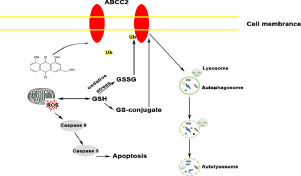当前位置:
X-MOL 学术
›
Phytomedicine
›
论文详情
Our official English website, www.x-mol.net, welcomes your feedback! (Note: you will need to create a separate account there.)
Aloe-emodin induces hepatotoxicity by the inhibition of multidrug resistance protein 2.
Phytomedicine ( IF 7.9 ) Pub Date : 2019-12-09 , DOI: 10.1016/j.phymed.2019.153148 De-Ming Liu 1 , Dong Yang 2 , Chun-Yan Zhou 3 , Jia-Si Wu 2 , Guo-Lin Zhang 4 , Ping Wang 2 , Fei Wang 4 , Xian-Li Meng 2
Phytomedicine ( IF 7.9 ) Pub Date : 2019-12-09 , DOI: 10.1016/j.phymed.2019.153148 De-Ming Liu 1 , Dong Yang 2 , Chun-Yan Zhou 3 , Jia-Si Wu 2 , Guo-Lin Zhang 4 , Ping Wang 2 , Fei Wang 4 , Xian-Li Meng 2
Affiliation

|
BACKGROUND
Aloe-emodin (AE) is among the primary bioactive anthraquinones present in traditional Chinese medicinal plants such as Rheum palmatum L. Multidrug resistance protein 2 (ABCC2/ MRP2) is an important efflux transporter of substances associated with cellular oxidative stress. However, the effects of traditional Chinese medicine on this protein remain unclear.
PURPOSE
The aim of this research is to study the role of ABCC2 in AE-induced hepatotoxicity.
METHODS
The expression of ABCC2 protein and mRNA levels were analyzed by Western-Blotting and qRT-PCR, respectively. The intracellular oxidative stress caused by AE was evaluated by quantifying the levels of intracellular reactive oxygen species, malondialdehyde, glutathione reduced and oxidized glutathione. The levels of adenosine triphosphate, mitochondrial membrane potential and mitochondrial DNA were explored to evaluate the effects of AE on mitochondrial function. The effects of AE on cell apoptosis and cell cycle were detected by flow cytometry. To further clarify the key role of ABCC2 in AE induced cytotoxicity, we used pCI-neo-ABCC2 plasmid to over express ABCC2 protein, and small interfering RNA was used to knockdown ABCC2 in HepG2 cells. Additionally, we investigated the impact of AE on ABCC2 degradation pathway and the hepatotoxic effects of AE in mice.
RESULTS
AE was found to inhibit ABCC2 transport activity, downregulate ABCC2 expression and altered intracellular redox balance. Induction of oxidative stress resulted in depletion of intracellular glutathione reduced, mitochondria dysfunction and activation of apoptosis. ABCC2 overexpression significantly reduced AE-induced intracellular oxidative stress and cell death, which was enhanced by ABCC2 knockdown. Furthermore, AE was observed to promote ABCC2 degradation through induction of autophagy and hepatotoxicity was induced in mice by promoting ABCC2 degradation.
CONCLUSIONS
The inhibition of ABCC2 is a novel effect of AE that triggers oxidative stress and apoptosis. These findings are helpful in understanding the toxicological effects of AE-containing medicinal plants.
中文翻译:

芦荟大黄素通过抑制多重耐药蛋白2诱导肝毒性。
背景技术芦荟大黄素(AE)是传统中草药植物(如大黄)中存在的主要生物活性蒽醌之一。耐多药蛋白2(ABCC2 / MRP2)是与细胞氧化应激相关的物质的重要外排转运蛋白。但是,中药对该蛋白的作用尚不清楚。目的本研究的目的是研究ABCC2在AE诱导的肝毒性中的作用。方法采用Western-Blotting和qRT-PCR方法分别检测ABCC2蛋白的表达和mRNA水平。通过量化细胞内活性氧,丙二醛,谷胱甘肽还原和氧化型谷胱甘肽的水平来评估由AE引起的细胞内氧化应激。三磷酸腺苷的水平 线粒体膜电位和线粒体DNA进行了探讨,以评估AE对线粒体功能的影响。流式细胞仪检测AE对细胞凋亡和细胞周期的影响。为了进一步阐明ABCC2在AE诱导的细胞毒性中的关键作用,我们使用了pCI-neo-ABCC2质粒过度表达ABCC2蛋白,并使用了小的干扰RNA来敲除HepG2细胞中的ABCC2。此外,我们调查了AE对ABCC2降解途径的影响以及AE对小鼠的肝毒性作用。结果发现AE抑制ABCC2转运活性,下调ABCC2表达并改变细胞内氧化还原平衡。氧化应激的诱导导致细胞内谷胱甘肽耗竭减少,线粒体功能障碍和细胞凋亡激活。ABCC2的过表达显着降低了AE诱导的细胞内氧化应激和细胞死亡,而ABCC2的抑制则增强了这种作用。此外,观察到AE通过诱导自噬而促进ABCC2降解,并且通过促进ABCC2降解在小鼠中诱导肝毒性。结论ABCC2的抑制是AE的一种新作用,可触发氧化应激和细胞凋亡。这些发现有助于理解含AE的药用植物的毒理作用。结论ABCC2的抑制是AE的一种新作用,可触发氧化应激和细胞凋亡。这些发现有助于理解含AE的药用植物的毒理作用。结论ABCC2的抑制是AE的一种新作用,可触发氧化应激和细胞凋亡。这些发现有助于理解含AE的药用植物的毒理作用。
更新日期:2019-12-09
中文翻译:

芦荟大黄素通过抑制多重耐药蛋白2诱导肝毒性。
背景技术芦荟大黄素(AE)是传统中草药植物(如大黄)中存在的主要生物活性蒽醌之一。耐多药蛋白2(ABCC2 / MRP2)是与细胞氧化应激相关的物质的重要外排转运蛋白。但是,中药对该蛋白的作用尚不清楚。目的本研究的目的是研究ABCC2在AE诱导的肝毒性中的作用。方法采用Western-Blotting和qRT-PCR方法分别检测ABCC2蛋白的表达和mRNA水平。通过量化细胞内活性氧,丙二醛,谷胱甘肽还原和氧化型谷胱甘肽的水平来评估由AE引起的细胞内氧化应激。三磷酸腺苷的水平 线粒体膜电位和线粒体DNA进行了探讨,以评估AE对线粒体功能的影响。流式细胞仪检测AE对细胞凋亡和细胞周期的影响。为了进一步阐明ABCC2在AE诱导的细胞毒性中的关键作用,我们使用了pCI-neo-ABCC2质粒过度表达ABCC2蛋白,并使用了小的干扰RNA来敲除HepG2细胞中的ABCC2。此外,我们调查了AE对ABCC2降解途径的影响以及AE对小鼠的肝毒性作用。结果发现AE抑制ABCC2转运活性,下调ABCC2表达并改变细胞内氧化还原平衡。氧化应激的诱导导致细胞内谷胱甘肽耗竭减少,线粒体功能障碍和细胞凋亡激活。ABCC2的过表达显着降低了AE诱导的细胞内氧化应激和细胞死亡,而ABCC2的抑制则增强了这种作用。此外,观察到AE通过诱导自噬而促进ABCC2降解,并且通过促进ABCC2降解在小鼠中诱导肝毒性。结论ABCC2的抑制是AE的一种新作用,可触发氧化应激和细胞凋亡。这些发现有助于理解含AE的药用植物的毒理作用。结论ABCC2的抑制是AE的一种新作用,可触发氧化应激和细胞凋亡。这些发现有助于理解含AE的药用植物的毒理作用。结论ABCC2的抑制是AE的一种新作用,可触发氧化应激和细胞凋亡。这些发现有助于理解含AE的药用植物的毒理作用。


























 京公网安备 11010802027423号
京公网安备 11010802027423号